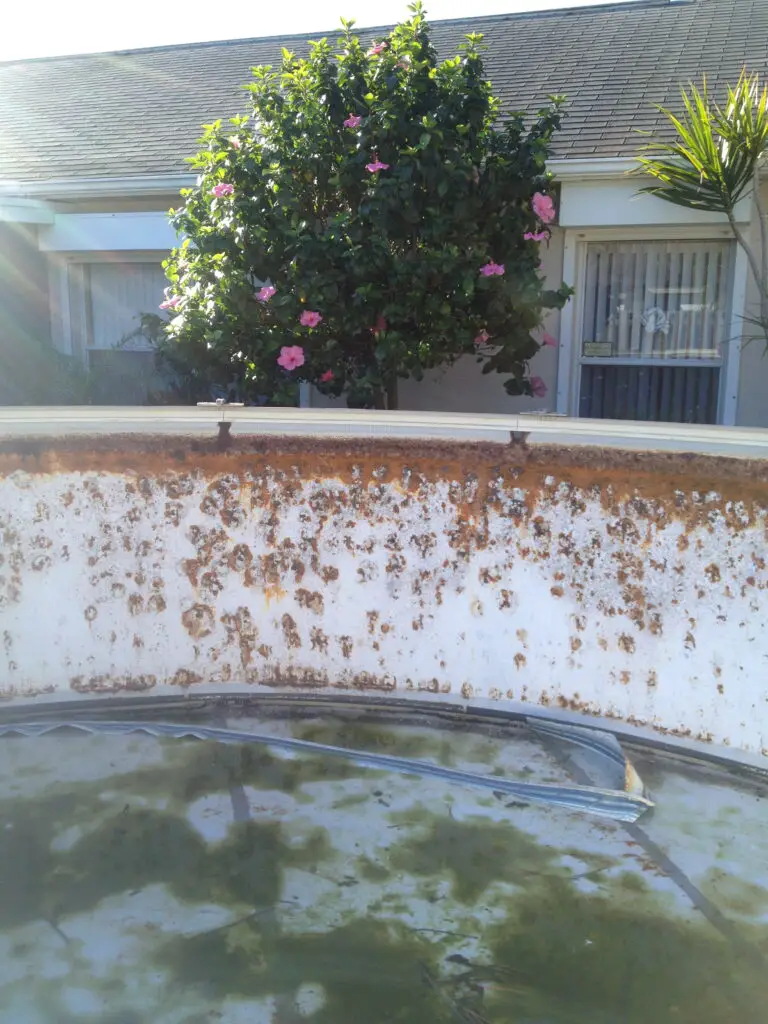On paper, choosing a beaded type liner for an above ground swimming pool seems like a good choice. Unfortunately though, due to a design issue, I can never or rarely recommend going with a beaded liner.

Beaded-type liners for above ground swimming pools attach to a channel that hangs down from the top of the pool’s wall. Since the beaded liner does not go all the way over the top of the wall, its application can allow for pool water to leak in between the outside of the liner and the inside of the wall. This trapped pool water can cause the wall to eventually rust.
BEADED LINERS REQUIRE A BEAD RECEIVER OR CHANNEL TO BE INSTALLED AT THE TOP OF THE POOL’S WALL. AND THAT’S THE PROBLEM
There are three ways a liner can be installed in an above-ground swimming pool.
1 Overlap liner (old school)
Overlap liners are designed to hang over the wall of the pool. And have any excess vinyl material lay on the outside of the wall. This is the old school type liner. You can see the finished product hanging over the outside of the pool.
An overlap liner requires plastic coping strips to be installed on top of the wall and over the liner to keep it in place. These aren’t as popular because you wind up either seeing the excess liner on the outside of the pool, or the excess has to be rolled up or folded over to hide it.
2 J-Hook liner (recommended by me)
J-hook liners have a thick “U-shaped” piece of vinyl at the top. It is designed to attach to the top of the pool’s wall and then hang down from that point into the pool.
J-hook liners are good in that they can have a specific tile pattern at the top. Which looks good in the pool. They also no longer require anything more than just the pool’s top stabilizer bars to keep them in place.
3 Beaded liner
This type of liner has a thick bead of vinyl at the top. It is designed to fit into a channel and then hang down into the pool from there.
A bead receiver or channel has to be installed all the way around the top of the pool wall. This channel will easily hook to the top of the wall. The channel will lay horizontal starting an inch or two down on the inside of the pool.
Once the bead receiver/channel has been installed, the bead of the liner will sort of “snap” into the channel and hang down from there.
Out of the three types of liners, the beaded liner is the only one that does NOT hang over the wall of the pool. That’s where the problem is.
BEAD CHANNELS OR RECEIVERS ALLOW POOL WATER TO GET BEHIND THE LINER

A metal-walled above ground pool is designed to have a metal outer wall (duh). Then a vinyl liner lay against it on the inside to hold the water.
Constant moisture causes corrosion, so it’s not good to have any water get in between the wall and the liner and just lay there. Normally, there can and will be some moisture and as long as it dries fairly quickly, no rust will begin.
If there is constant pool water getting behind the liner and against the inside of the pool’s wall, then that will cause rust or corrosion.
Bead channels/receivers allow water to get between the liner and the wall. Not good.
HOW BEAD RECEIVERS/CHANNELS ALLOW WATER TO GET BEHIND THE LINER.

Bead channels come in 4 or 5 foot pieces. They are installed right next to each other on top of the wall to form a continuous channel all the way around the pool so the bead of the liner can snap in everywhere.
Although the pieces of channel butt right next to each other, there is a very small gap that can allow water to get behind them. This is where the problem is. If the bead channel was a continuous piece all the way around the top of the pool, there would be no way water could get in. But that’s not the way it is.
WHY SOME CHOOSE TO HAVE A BEADED LINER
As stated at the beginning of this article, beaded-type liners are a good idea on paper. And if their channels didn’t allow water to get to the inside of the liner, I would recommend them for most.
The big advantage to a beaded liner is that they are easier to change out. Since beaded liners don’t go all the way over the pool wall, you don’t have to take as much of the pool apart to replace them. With some pool models, hardly any of the top of the pool has to come off which is very nice.
Not having to take as much of the pool apart during a liner replacement can be good for two situations.
If a deck has been built next to the pool and is in the way of taking the top rails off or even the top caps, then it’s nice to have a beaded liner. I can’t tell you how many times (despite my advice on how and where to build a deck) I’ve had to cut a perfectly good deck in order to take the pool apart for a new liner.
People choose a beaded liner so they can build their pool deck and not have to worry as much about leaving room to take the top rails off years later during the liner change.
The second reason people choose a beaded liner is if the pool is going deep in the ground. Above ground pools can be installed partially in the ground, but if they go in deep (more than half-way down) then they are prone to caving in when emptied.
Not having to take the top of the pool completely apart to get a new liner in it can make the difference between the walls caving in and not. That’s a big reason to have a beaded liner.
Many above ground pools will be set up with both of the above. It will be in the ground AND will have a deck around it. These are good candidates for having a beaded liner. It’s a shame that their needed channels rust out the pool’s wall from the inside.
IF YOU MUST USE A BEADED LINER
If you are reading this article, then you know that I do like the beaded liner application for above grounds. But the major issue of the bead channels allowing water to get behind the liner is too big to dismiss, and so I only rarely recommend them.
Some people want what they want though. They want their semi-inground pool (which is just an above-ground pool in the ground) all the way in and they want some kind of permanent deck closely to and all the way around the pool. And despite my advice against doing either, they are going forward with that.
Hey, that’s cool. It’s your money and it’s your yard. If you pay me, I’ll give you what you want. You may not get me to change the liner out in 5-8 years when it needs it because the job will be a major pain in the ass, but someone will do it.
So then, if you are dead set at having a beaded liner in your above ground swimming pool, then try to waterproof the bead channel where each piece comes together.
This means that you will have to silicone or fuse each piece of bead channel at each union all the way around the pool. I have not yet seen an entirely successful method on how to do this, so I will not recommend any particular way. I will say that I think it’s possible to waterproof the channel gaps and will say that even attempting to do it may help a lot at the wall not rusting out.
However way you try to do this, I recommend you trying to waterproof the channel BEFORE installing the liner. Also, don’t let your modification disturb the channel itself. That needs to be gapped well all the way around so the liner goes in and stays. GOOD LUCK!


I have seen semi ingrounds with a block wall adjacent to the pool all around it. In some pics, these walls are “capped” with a top stone that appears to be right on top of the stone wall as well as the pool ledge. In this instance, what type of liner would need to be used?
First off, just because a pool has a beaded liner doesn’t mean that at least some of the top of the pool has to come off when changing the liner. It really depends on how low the bead receiver/channel hangs below the top rails and the design of the top caps.
I mention this because I have seen situations like what you describe above and the decking still has to partially be removed to perform the “beaded” liner change. So don’t make the mistake of thinking that you are in the clear to just place a permanent deck over top rails just because it has a bead channel(beaded liner).
To answer your question now, I would still recommend a j-hook type liner. I think it’s better to design the decking in a way so the top of the pool can come apart and have minimal room to change a j-hook liner. I feel that strongly about having the liner go completely over the wall.
Keep in mind that when the bead channel allows water to get behind the liner and sit on the wall, there are big odds that it will cause it to rust. And when you have to replace the pool because the wall rusted out, then at that point, you’ll have to remove permanent decking to replace the pool. Are you catching what I’m throwing you here? lol